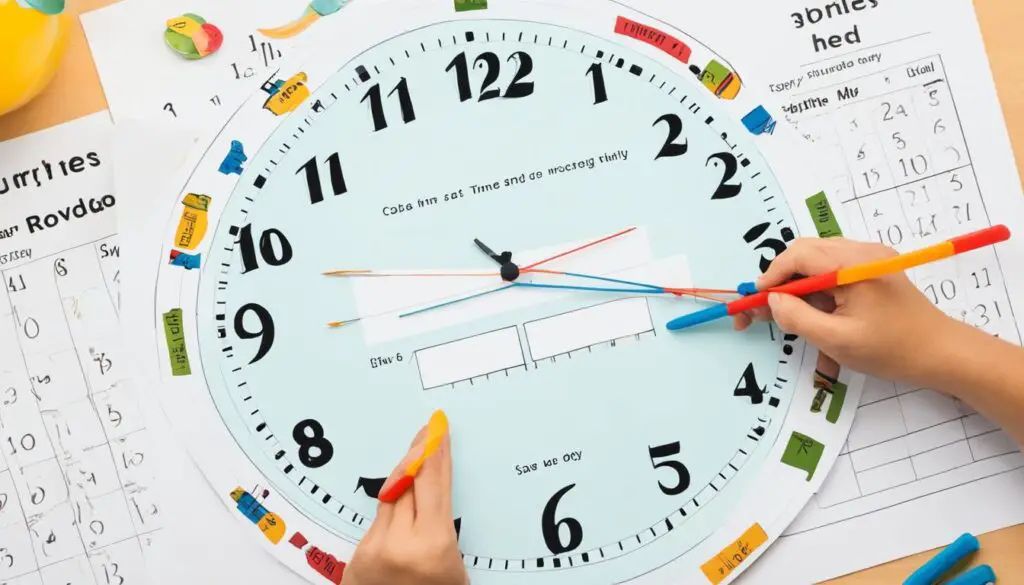
Building a Supportive Home Learning Environment for Kids
As a parent, I understand the challenges that come with ensuring your child gets the best possible education. With remote learning becoming the norm, it’s more critical than ever to establish a supportive home learning environment that promotes your child’s academic growth and success.
Creating such an environment requires intentional effort, but the benefits are well worth it. A supportive home learning environment can help your child feel confident, motivated, and engaged in their studies, leading to improved academic performance and a love for learning.
Key Takeaways:
- A supportive home learning environment is crucial for a child’s academic success.
- Intentional effort is required to establish a supportive home learning environment.
- The benefits of a supportive home learning environment include increased confidence, motivation, and engagement in learning.
- An effective learning space and a consistent routine are essential elements of a supportive home learning environment.
- Interactive learning activities can help promote a love for learning and stimulate curiosity in children.
Designing a Dedicated Learning Space
Creating a dedicated learning space for your child is a fundamental step in building a supportive home learning environment. A designated area promotes concentration, minimizes distractions, and enhances focus, making it easier for your child to engage in learning activities.
When designing a learning space, consider the following elements:
| Element | Description |
|---|---|
| Comfortable Seating | Choose a chair and desk that are comfortable and appropriately sized for your child’s age and height. |
| Proper Lighting | Ensure the space is well-lit with natural light or artificial light that does not strain the eyes. |
| Minimal Distractions | Provide a clutter-free zone that minimizes distractions and noise. Avoid placing toys or electronic devices in the learning space. |
| Learning Materials | Stock the space with learning materials, such as books, writing tools, and educational games. Ensure all materials are age-appropriate and relevant to your child’s interests and learning goals. |
Additionally, consider choosing a dedicated location for the learning space, such as a specific corner of the room or a separate room altogether, to establish a clear boundary between learning and leisure activities.
Finally, involve your child in the design process by encouraging them to express their preferences and share their ideas for the space. A collaborative effort can make the learning space more personalized and enjoyable for your child.
Establishing a Consistent Routine
One of the most effective ways to foster a supportive home learning environment is to establish a consistent routine for your child’s studies. A structured schedule can bring much-needed stability and predictability to your child’s day, helping them anticipate and prepare for their learning tasks.
A consistent routine can also improve your child’s time management skills, encourage self-discipline, and promote focus and concentration. By setting aside dedicated periods for learning, your child will develop a sense of responsibility and ownership over their educational pursuits, ultimately leading to greater academic success in the long run.
To create a balanced routine, start by establishing a set wake-up time and bedtime for your child. Then, allocate specific times for academic subjects, extracurricular activities, meals, and breaks. Be sure to take your child’s natural rhythms and preferences into account as you plan their schedule, and allow for some flexibility when necessary.
Breaks and transitions are also critical components of a successful routine. Encourage your child to take frequent breaks between learning tasks to recharge their energy and refocus their attention. Transitions between activities should also be smooth and seamless to minimize distractions and disruptions.

“A consistent routine is key to creating a positive and productive learning experience for your child.”
Engaging in Interactive Learning Activities
Interactive learning activities are a fantastic way to spark your child’s curiosity and love for learning. There are many options available that not only educate but also entertain children.
Hands-on Activities
Hands-on activities are perfect for engaging children in interactive learning experiences. They allow your child to explore and learn through experimentation and creativity. Some fun hands-on activities you can try include:
- Making homemade playdough and using it to shape numbers and letters
- Building structures with cardboard boxes and tubes
- Creating science experiments with common household items
These activities provide a fun and unique way for your child to learn while also stimulating their imagination.
Educational Games
Educational games are another great way to engage your child in interactive learning. Many games are available online or in app form, and cover a range of subjects from math to reading. Not only are they fun, but they can also help your child develop important skills they’ll need to succeed in school and beyond.
Some popular educational games include:
- Math Games:
- Prodigy Math Game
- Math Playground
- Reading Games:
- ABCya!
- Starfall
- Science Games:
- NASA Kids’ Club
- Science Kids
These games provide a fun and convenient way for your child to learn and reinforce important concepts.
Online Resources
There are numerous online resources available to help you engage your child in interactive learning. YouTube has a wealth of educational channels and videos covering a variety of subjects. For example, CrashCourse offers short educational videos covering topics like history, science, and literature.
You can also find interactive resources on websites like PBS LearningMedia and Khan Academy. These resources provide a wide range of educational content and activities for children of all ages.

Conclusion
In conclusion, building a supportive home learning environment for kids is crucial to their academic success and overall well-being. By designing a dedicated learning space, establishing a consistent routine, and engaging in interactive learning activities, parents can create a nurturing space that fosters their child’s love for learning.
As a journalist, my research has shown that children thrive in an environment that is structured, yet flexible, and encourages exploration and curiosity. By implementing the practical tips provided in this article, parents can take an active role in their child’s education and provide them with the support they need to succeed.
Ultimately, a supportive home learning environment is not just about academic achievement, but also about fostering a positive relationship between children and their parents. By working together to create a space that promotes learning and growth, parents can strengthen their bond with their child and lay the foundation for a successful future.
FAQ
Why is a supportive home learning environment important for kids?
A supportive home learning environment is crucial for kids as it helps create a positive and conducive atmosphere for their academic development. It fosters their motivation, focus, and engagement, leading to better learning outcomes.
How can I design a dedicated learning space for my child?
Designing a dedicated learning space involves choosing a quiet and well-lit area in your home where your child can study without distractions. It should be equipped with essential supplies such as a desk, chair, and storage for books and materials.
What are the benefits of establishing a consistent routine?
A consistent routine provides structure and stability to your child’s learning journey. It helps them stay organized, manage their time effectively, and develop a sense of responsibility and discipline. Additionally, a routine promotes focus and reduces anxiety.
How can I engage my child in interactive learning activities?
There are various ways to engage your child in interactive learning activities. You can incorporate hands-on experiments, arts and crafts, educational games, and technological tools into their learning experience. Online resources such as educational websites and interactive apps can also be beneficial.
What is the importance of building a supportive home learning environment?
Building a supportive home learning environment is crucial for your child’s educational success. It provides them with the necessary tools, structure, and encouragement to thrive academically. A supportive environment fosters their love for learning, boosts their confidence, and helps them develop essential skills.